Study on Characteristics of Coal Spontaneous Combustion in Kerjian Mining Area, Xinjiang, China
Abstract
:1. Introduction
2. Materials and Method
2.1. Coal Samples
2.2. Nuclear Magnetic Resonance Carbon Spectrum (13C-NMR)
2.3. X-ray Photoelectron Spectroscopy (XPS)
2.4. High-Resolution Transmission Electron Microscope (HRTEM)
2.5. Fourier Transform Infrared Spectroscopy (FTIR)
2.6. X-ray Diffraction Spectrum (XRD)
2.7. Thermogravimetric Analysis (TG)
2.8. Characteristic Temperature and Kinetic Parameters
3. Construction of Coal Molecular Structure
3.1. 13C-NMR Test Results and Analysis
3.2. XPS Test Results and Analysis
3.3. HRTEM Test Results and Analysis
3.4. Coal Molecular Structural Model
3.4.1. Aromatic Structure
3.4.2. Aliphatic Hydrocarbon Carbon Structure
3.4.3. Heteroatoms
3.4.4. Molecular Structural Model
3.4.5. Model Optimization
4. Results and Analysis
4.1. Characteristics of Coal Molecular Structure
4.1.1. FTIR Test Results and Analysis
4.1.2. XRD Test Results and Analysis
4.2. TG Test Results and Analysis of Coal Samples at Different Temperatures
4.2.1. Raw Coal
4.2.2. Coal Samples at Different Temperatures
4.3. FTIR Test Results and Analysis of Coal Samples at Different Temperatures
4.4. HRTEM Test Results and Analysis of Coal Samples at Different Temperatures
5. Conclusions
- (1)
- According to 13C-NMR and HRTEM, the aromatic structures of the Kerjian coal samples are dominated by naphthalene and supplemented by benzene and anthracene. The aliphatic hydrocarbons are dominated by alkyl side chains. The main forms of heteroatom oxygen, nitrogen, and sulphur were OH and C-O, N-5 and N-6, and aliphatic sulphur, in that order. The structural formula was C142H112N2O22. The most stable three-dimensional structure of the coal molecule was obtained using geometric optimization and energy minimization. Moreover, the final energy was mainly dominated by van der Waals energy.
- (2)
- The coal samples were divided into seven characteristic temperature points and five oxidation reaction stages. The temperatures of different coal samples from T5 to T6 did not change considerably. T1 and T2 showed decreasing trends overall in different oxidized coal samples, and there were inflection points in individual oxidized coal samples. T3 and T4 varied greatly, and their overall trends were basically the same, both decreased first and then increased, in which there are also individual inflection points. The value of the activation energy in stage was the largest and fluctuated with increasing oxidation temperature. An inflection point occurred in stage 3 in the 250 °C coal sample, decreasing first and then increasing. The activation energy of stage 2 showed an overall trend of increasing and then decreasing. The activation energy in stage 1 fluctuated, and the activation energy of stages 1 and 2 were the smallest among the coal samples.
- (3)
- At different oxidation temperatures, the self-associated OH content changes more and these compounds became more active. The contents of OH-OR2, cyclic OH, and OH-π changed less, and the main changes occurred at 250 °C and 350 °C. The content of aliphatic hydrocarbon varied remarkably in the ranges of 30–150 °C and 300–500 °C, and the main temperature points were 50 °C and 150 °C. The C-O content of the oxygen-contained functional group showed an increasing trend and high activity at each stage. The C=O consistently decreased in each stage. The content of benzene substituents was more variable, and changes mainly occurred at 150–300 °C.
- (4)
- The aromatic fringes in the 11 coal samples were dominated by naphthalene and 2 × 2 fringes, the contents of which accounted for more than 80% of the total fringes in the samples. The 1 × 1 fringe had a maximum value of 59% at 100 °C, and then decreases until the inflection point at 300 °C, where the content increased and decreased after 400 °C. The value of 2 × 2 fringes decreased with increasing oxidation temperature, increased slightly after 150 °C, reached 34% at 350 °C, and then increased again with a peak at 450 °C. The 3 × 3 fringe showed a trend of increasing, decreasing, and then increasing with an increase in the oxidation temperature.
Author Contributions
Funding
Data Availability Statement
Conflicts of Interest
References
- Chen, C.K.; Xian, X.F. Research on coal structure and its development. Coal Convers. 1998, 21, 7–13. [Google Scholar]
- Bhoi, S.; Banerjee, T.; Mohanty, K. Molecular dynamic simulation of spontaneous combustion and pyrolysis of brown coal using ReaxFF. Fuel 2014, 136, 326–333. [Google Scholar] [CrossRef]
- Zhang, R.; Xia, Y.C.; Tan, J.L.; Ding, S.; Xing, Y.; Gui, X. Analysis and study of molecular carbon structure of low-rank coal. China Coal 2018, 44, 88–94. [Google Scholar]
- Mathews, J.P.; Chaffee, A.L. The molecular representations of coal—A review. Fuel 2012, 96, 1–14. [Google Scholar] [CrossRef]
- Shinn, J.H. Towards an understanding of the coal structure. Fuel 1960, 39, 147. [Google Scholar]
- Wiser, W.H. Reported in division of fuel chemistry. Preprints 1975, 20, 122. [Google Scholar]
- Given, P.H. The distribution of hydroxyl in coal and its relation to coal structure. Fuel 1960, 39, 147–153. [Google Scholar]
- Solomon, P.R.; Blaustein, B.D.; Bockrath, B.C.; Friedman, S. Coal structure and thermal decomposition. ACS Symp. Ser. 1981, 169, 61–71. [Google Scholar] [CrossRef]
- Zhang, Z.; Kang, Q.; Wei, S.; Yun, T.; Yan, G.; Yan, K. Large scale molecular model construction of Xishan bituminous coal. Energy Fuels 2017, 2, 1310–1317. [Google Scholar] [CrossRef]
- Xue, F.J.; Hu, Y.; Zhang, Z.X. Structural model construction and quantum chemical analysis of Zhaotong lignite. Coal Chem. Ind. 2016, 39, 12–15. [Google Scholar]
- Zhang, S.; Ma, R.J.; Liu, L.; Zhang, H.; Liu, Q.F. Molecular structure characteristics and model construction of anthracite in Zhalute area. Coalf. Geol. Explor. 2020, 48, 62–69. [Google Scholar]
- Chai, S.Q.; Zeng, Q. Molecular model construction and structural characteristics analysis of Wucai-wan coal in Eastern Junggar Coalfeild based on quantum chemistry theory. J. China Coal Soc. 2022, 1–12. [Google Scholar]
- Ma, R.J.; Zhang, S.; Hou, D.D.; Liu, W.Y.; Yuan, L.; Liu, Q.F. Construction of molecular structure model and structure optimization of high-coal-grade coal in Fengxian, Shaanxi. J. China Coal Soc. 2019, 44, 1827–1835. [Google Scholar]
- Wu, S.; Jin, Z.; Deng, C. Molecular simulation of coal-fired plant flue gas competitive adsorption and diffusion on coal. Fuel 2019, 239, 87–96. [Google Scholar] [CrossRef]
- Wei, S.; Yan, G.C.; Zhang, Z.Q.; Liu, S.M.; Zhang, Y.F. Characterization of the molecular structure of Jincheng anthracite. J. China Coal Soc. 2018, 43, 555–562. [Google Scholar]
- Xiang, J.H.; Zeng, F.G.; Liang, H.Z.; Sun, P.L.; Zhang, L.; Li, M.F.; Jia, J.B. Structural modeling of Gunzhou coal macromolecules and its molecular simulation. J. Fuel Chem. 2011, 39, 481–488. [Google Scholar] [CrossRef]
- Ren, X.B.; Xin, W.H.; Zhang, Y.T.; Zhou, A.N. Study on the microcrystalline structure of low-order bituminous coal based on HRTEM. J. China Coal Soc. 2015, 40, 242–246. [Google Scholar]
- Sun, C.; Wei, X.; Kang, R.; Bin, F.; Li, S. Intrinsic sodium occurrence in Zhundong coal: Experimental observations and molecular modeling. Fuel 2021, 305, 121491. [Google Scholar] [CrossRef]
- Hong, D.K.; Liu, L.; Cao, Z.; Yang, C.M.; Guo, X. Molecular dynamics study of the reaction of Wucaiwan coal pyrolysis. J. China Coal Soc. 2019, 44, 271–277. [Google Scholar]
- Zhu, H.Q.; He, X.; Huo, Y.J.; Xie, Y.; Wang, W.; Fang, S. Molecular structure model construction and optimization of lignite. J. Min. Sci. 2021, 6, 429–437. [Google Scholar]
- Wornat, M.J.; Hurt, R.H.; Yang, N.Y.C.; Headley, T.J. Structural and Compositional Transformations of Biomass Chars during Combustion. Combust. Flame 1995, 100, 131–143. [Google Scholar] [CrossRef]
- Jia, L.; Yu, Y.; Li, Z.-P.; Qin, S.-N.; Guo, J.-R.; Zhang, Y.-Q.; Wang, J.-C.; Zhang, J.-C.; Fan, B.-G.; Jin, Y. Study on the Hg0 removal characteristics and synergistic mechanism of iron-based modified biochar doped with multiple metals. Bioresour. Technol. 2021, 332, 125086. [Google Scholar] [CrossRef]
- Xiao, Y.; Ye, X.X.; Liu, K.H. Study on the transformation of key functional groups in the spontaneous combustion of secondary oxidized coal. J. China Coal Soc. 2021, 46, 989–1000. [Google Scholar]
- Li, X.Q.; Zeng, Q. HRTEM analysis of the aggregate structure and ultrafine microporous characteristics of Xinjiang Zhundong coal under heat treatment. Sci. Rep. 2022, 12, 4994. [Google Scholar] [CrossRef]
- Wang, C.-P.; Duan, X.-D.; Xiao, Y.; Li, Q.-W.; Deng, J. Thermokinetic Characteristics of Coal Combustion under High Temperatures and Oxygen-Limited Atmospheres. Combust. Sci. Technol. 2022, 194, 1282–1300. [Google Scholar] [CrossRef]
- Yi, X.; Xiao, Y.; Lü, H.; Shu, C.M.; Deng, J.L. Thermokinetic Behavior and Microcharacterization during the Spontaneous Combustion of 1/3 Coking Coal. Combust. Sci. Technol. 2019, 191, 1769–1788. [Google Scholar] [CrossRef]
- GB/T212-2008; Proximate Analysis of Coal. Standardization Administration of China: Beijing, China, 2008.
- Zhu, H.Q.; Guo, A.D.; Qu, L.N. Experimental study on the relationship between coal thermodynamic parameters, characteristic temperature and volatile fraction. Chin. J. Saf. Sci. 2012, 22, 55–60. [Google Scholar]
- Liu, J.; Chen, W.S.; Qi, Q.J. Study on the propensity of spontaneous combustion of coal based on activation energy index. J. China Coal Soc. 2005, 30, 67–70. [Google Scholar]
- Trewhella, M.J.; Poplett, L.J.F.; Grint, A. Structure of Green River oil shale kerogen: Determination using solid state 13C n.m.r. spectroscopy. Fuel 1986, 65, 541–546. [Google Scholar] [CrossRef]
- Zheng, Y.H.; Dai, Z.S. Study of the effect of low temperature heat treatment on the chemical composition structure of low coalification coal by NMR. Coal Convers. 1997, 20, 54–59. [Google Scholar]
- Yin, Z.J.; Wang, T.; Xing, H.Z. Techniques of XPS data processing methods. Shandong Chem. Ind. 2017, 46, 89–91. [Google Scholar]
- Yao, M.Y.; Liu, Y.H.; Che, D.F. Study on the morphology of nitrogen in Yibin coal and its variation pattern. J. Xi’an Jiaotong Univ. 2003, 37, 759–763. [Google Scholar]
- Chang, H.Z.; Wang, C.H.; Zeng, F.G.; Li, J.; Li, W.Y.; Xie, K.C. Comparative XPS analysis of the surface structure of coal microfraction groups with different reduction levels. J. Fuel Chem. 2006, 34, 389–394. [Google Scholar]
- Grzybek, T.; Pietrzak, R.; Wachowska, H. X-ray photoelectron spectroscopy study of oxidized coals with different sulphur content. Fuel Process. Technol. 2002, 77, 1–7. [Google Scholar] [CrossRef]
- Yuegang, T.; Xuan, H.; Chunyuan, L.; Xu, M. Effects of Coal Rank and High Organic Sulphur on the Structure and Optical Properties of Coal-based Graphene Quantum Dots. Acta Geol. Sin. 2018, 92, 1218–1230. [Google Scholar]
- Kozłowski, M. XPS study of reductively and non-reductively modified coals. Fuel 2004, 83, 259–265. [Google Scholar] [CrossRef]
- Niekerk, D.V.; Mathews, J.P. Molecular representations of Permian-aged vitrinite-rich and inertinite-rich South African coals. Fuel 2010, 89, 73–82. [Google Scholar] [CrossRef]
- Nosé, S. A unified formulation of the constant temperature molecular dynamics methods. J. Chem. Phys. 1984, 81, 511–519. [Google Scholar] [CrossRef] [Green Version]
- Marzec, A. Intermolecular interactions of aromatic hydrocarbons in carbonaceous materials: A molecular and quantum mechanics. Carbon 2000, 38, 1863–1871. [Google Scholar] [CrossRef]
- Yu, H.Y.; Sun, X.G. Infrared spectroscopic study on the hydrocarbon formation mechanism of Late Permian coal in Leping, Jiangxi. Spectrosc. Spectr. Anal. 2007, 27, 858–862. [Google Scholar]
- Feng, L.; Zhao, G.; Zhao, Y.; Zhao, M.; Tang, J. Construction of the molecular structure model of the Shengli lignite using TG-GC/MS and FTIR spectrometry data. Fuel 2017, 203, 924–931. [Google Scholar] [CrossRef]
- Zhang, W.; Zeng, F.G. Infrared spectroscopic analysis of hydroxyl groups in moderately metamorphosed coal. J. Taiyuan Univ. Technol. 2005, 36, 545–548. [Google Scholar]
- Xiang, J.H.; Zeng, F.G.; Liang, H.Z.; Li, M.F.; Song, X.X.; Zhao, Y.Y. Carbon structure characteristics of coals with different degrees of metamorphism and their evolutionary mechanisms. J. China Coal Soc. 2016, 41, 1498–1506. [Google Scholar]
- Qi, X.Y. Oxidation and self-reaction processes of reactive groups in coal. J. China Coal Soc. 2011, 36, 2133–2134. [Google Scholar]

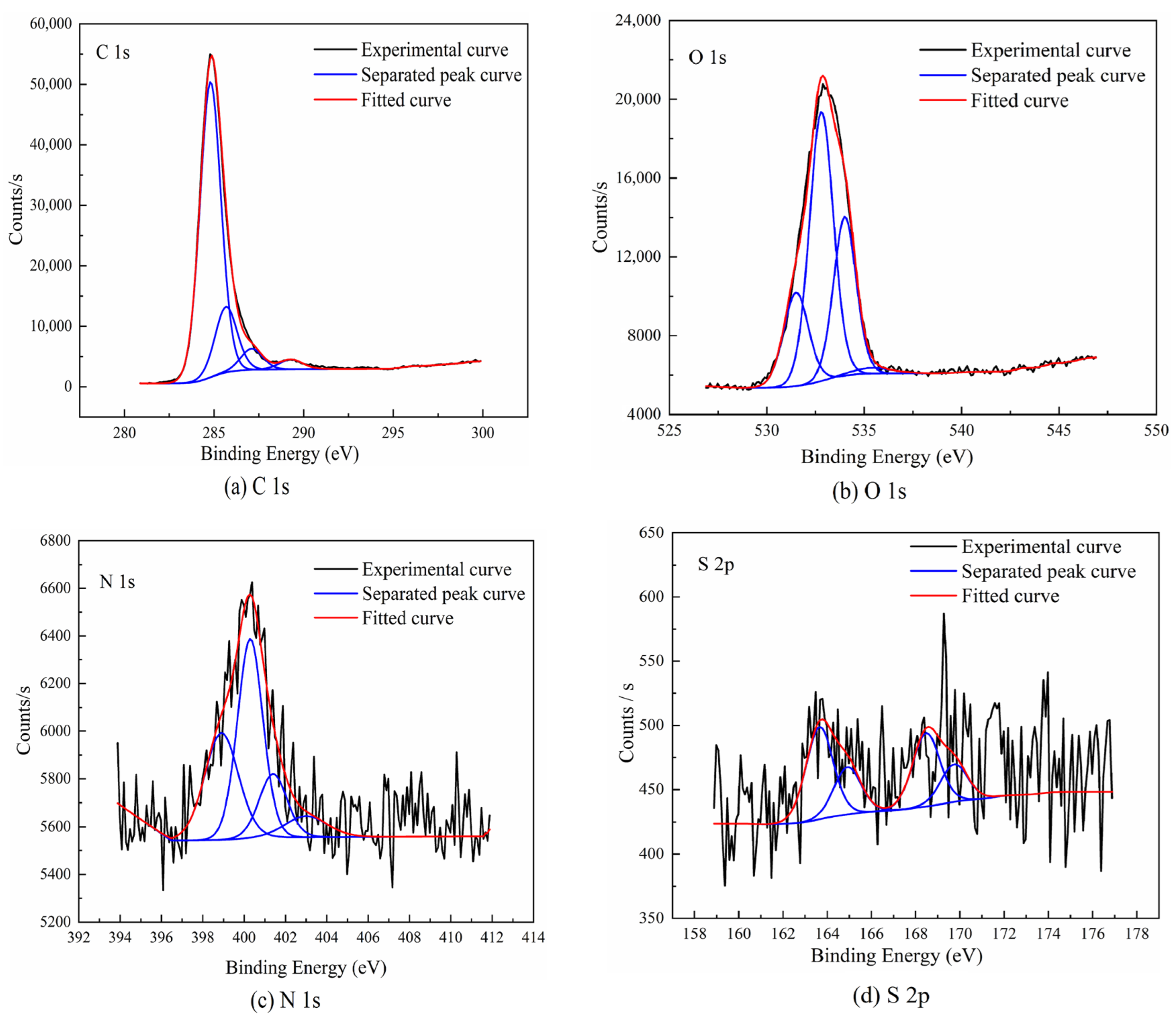
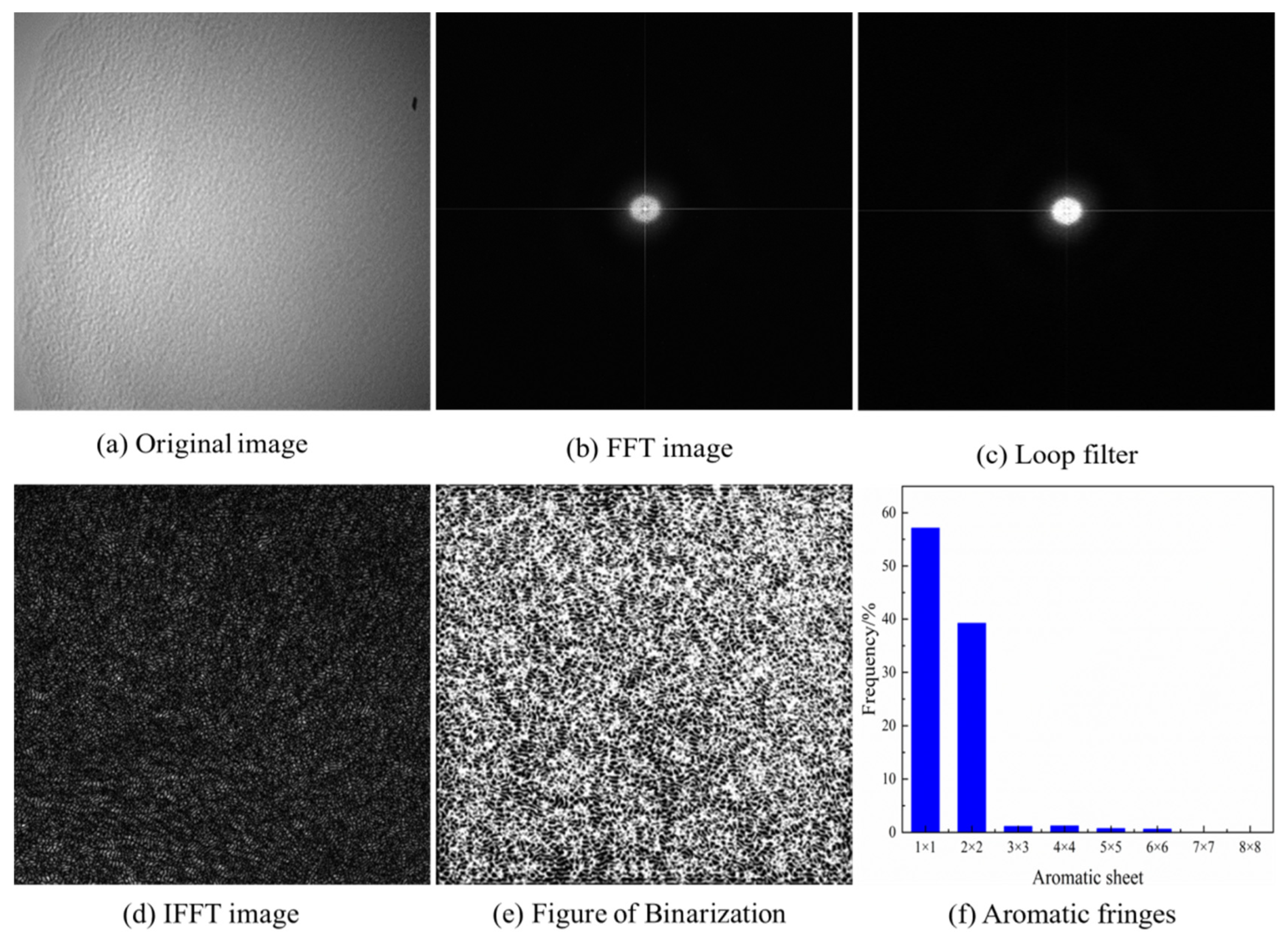
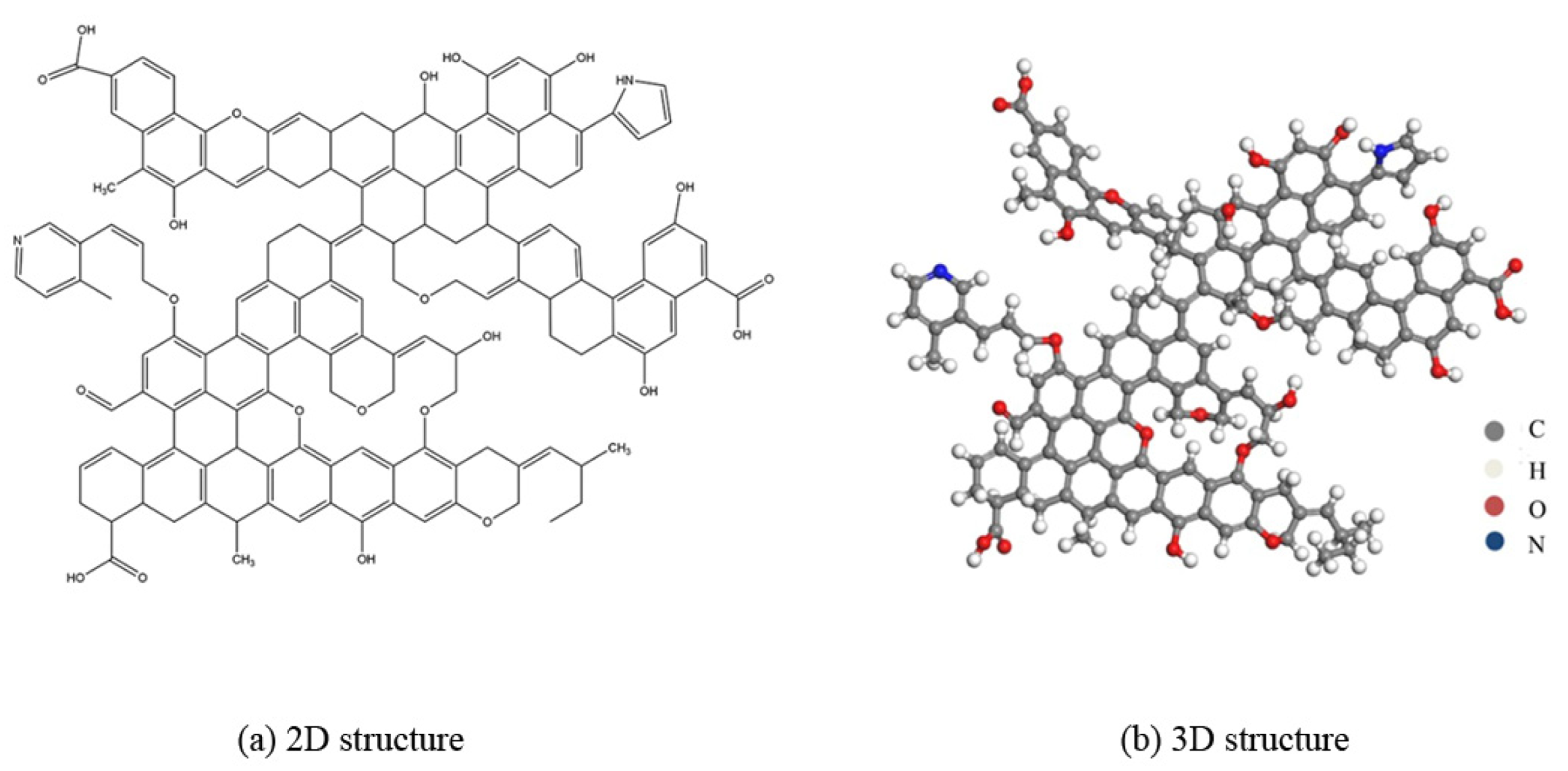
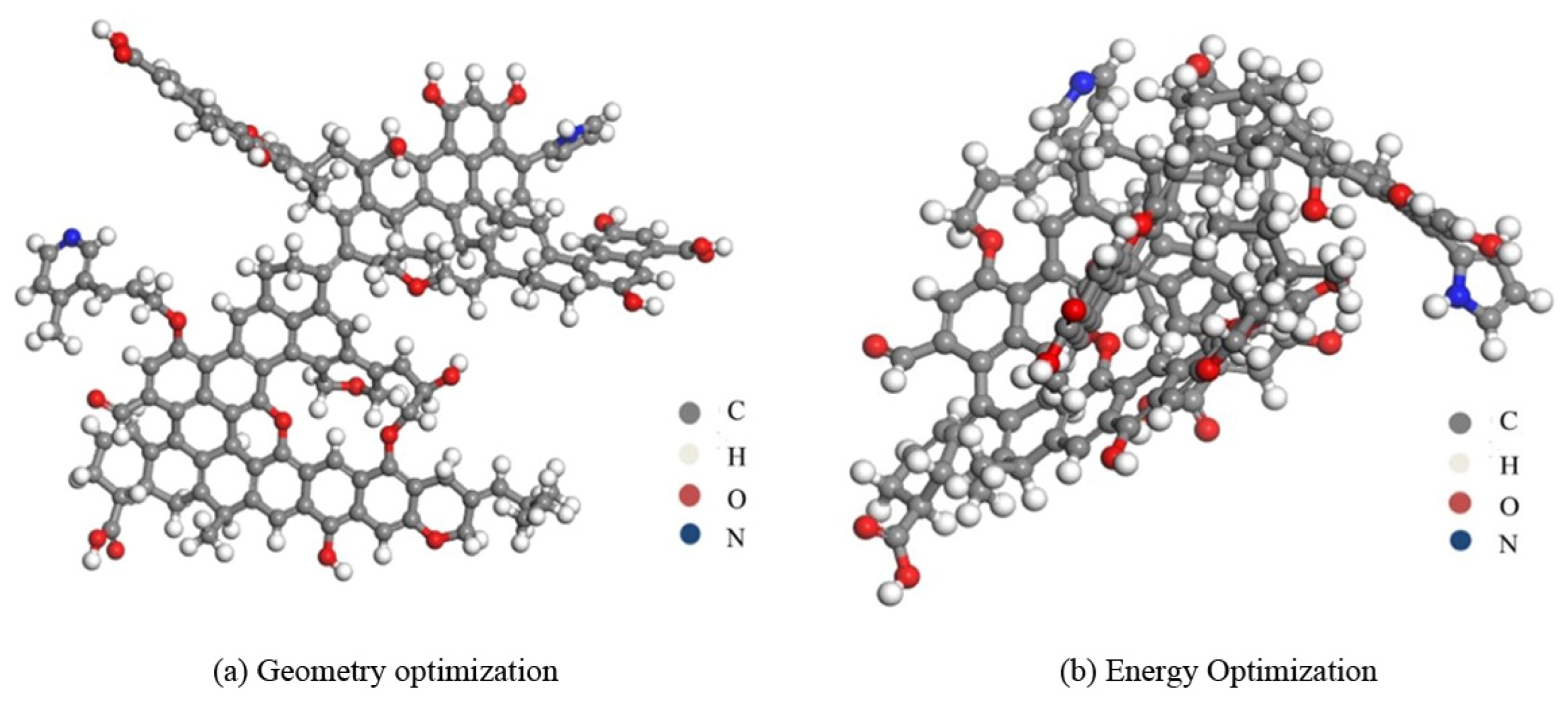
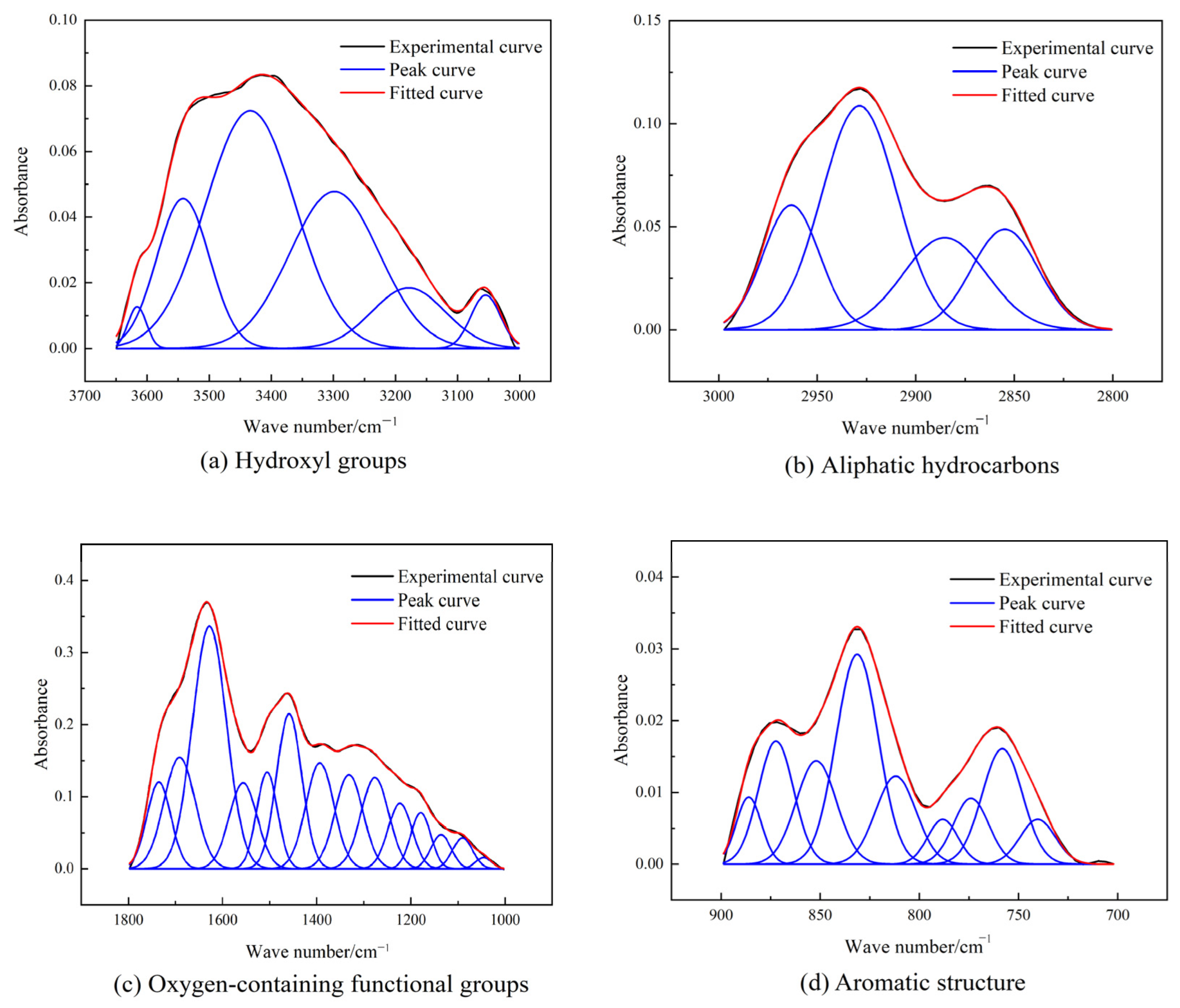
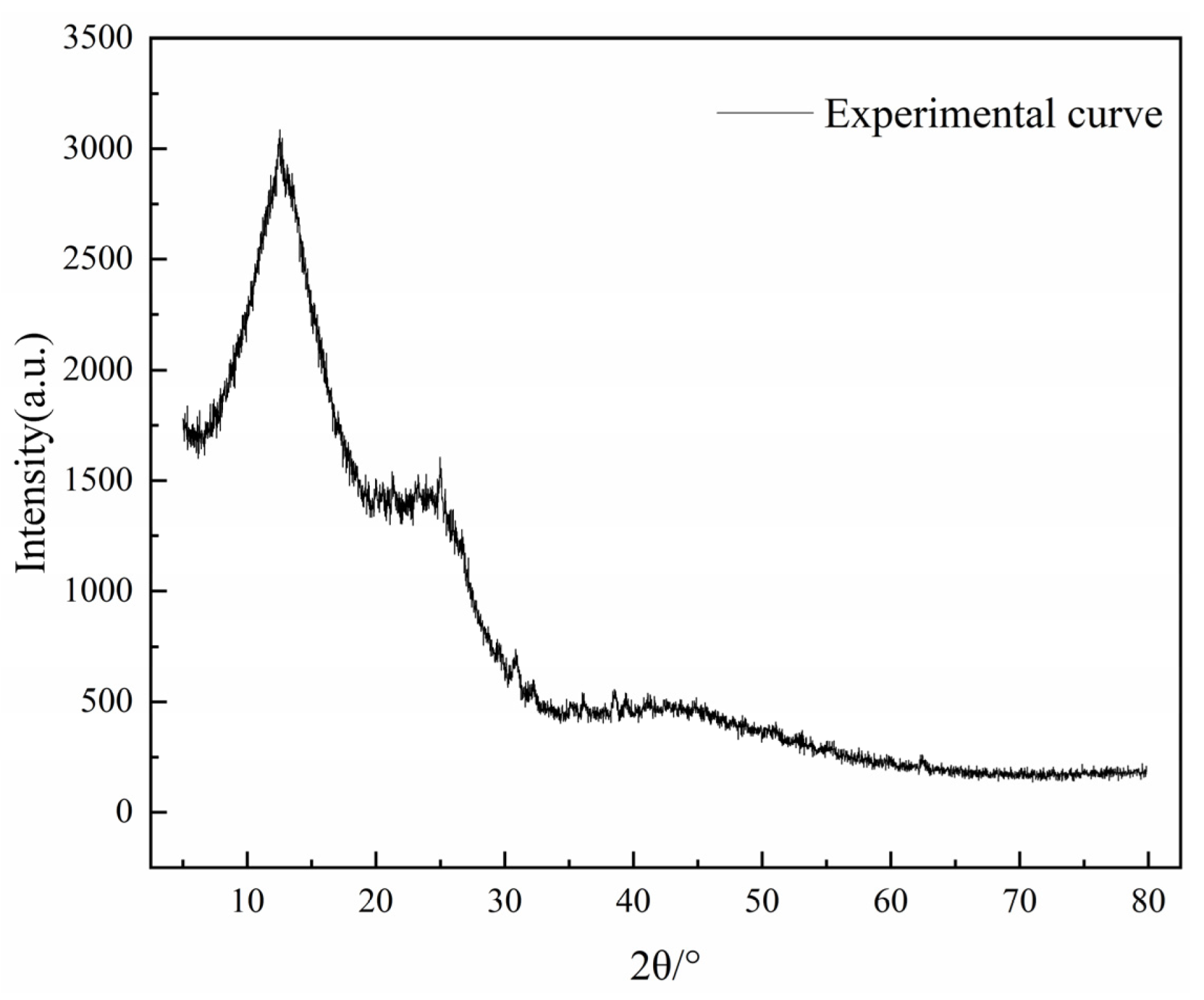

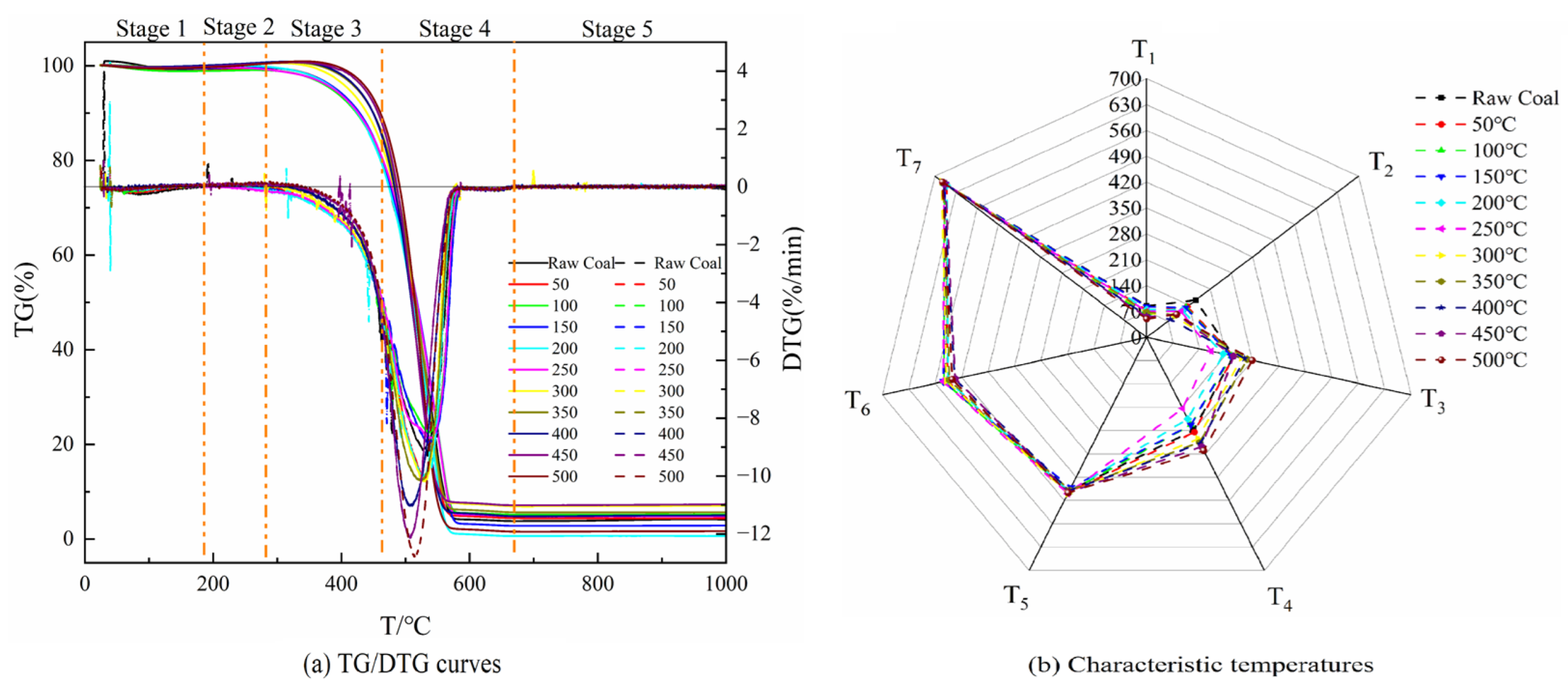
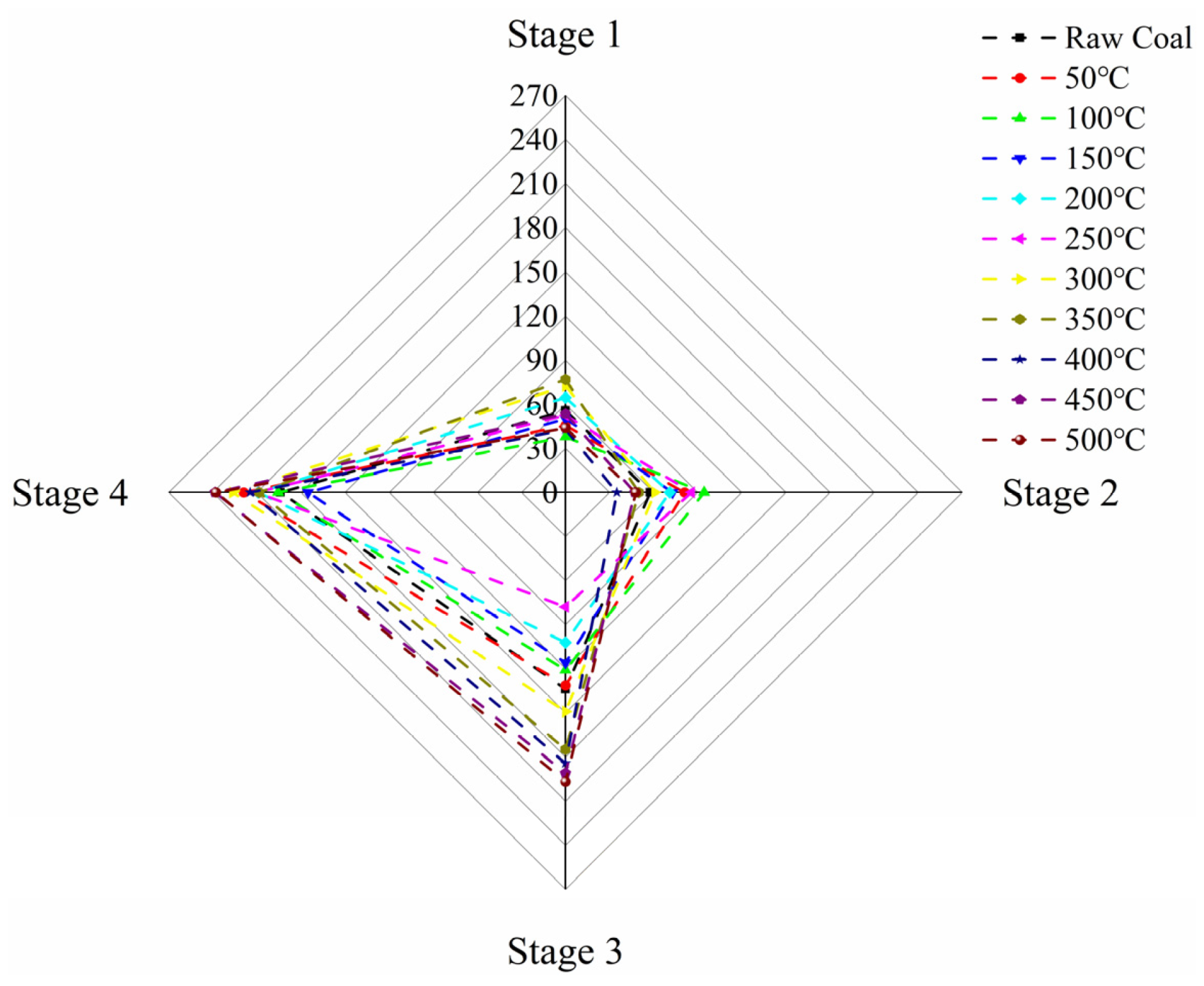
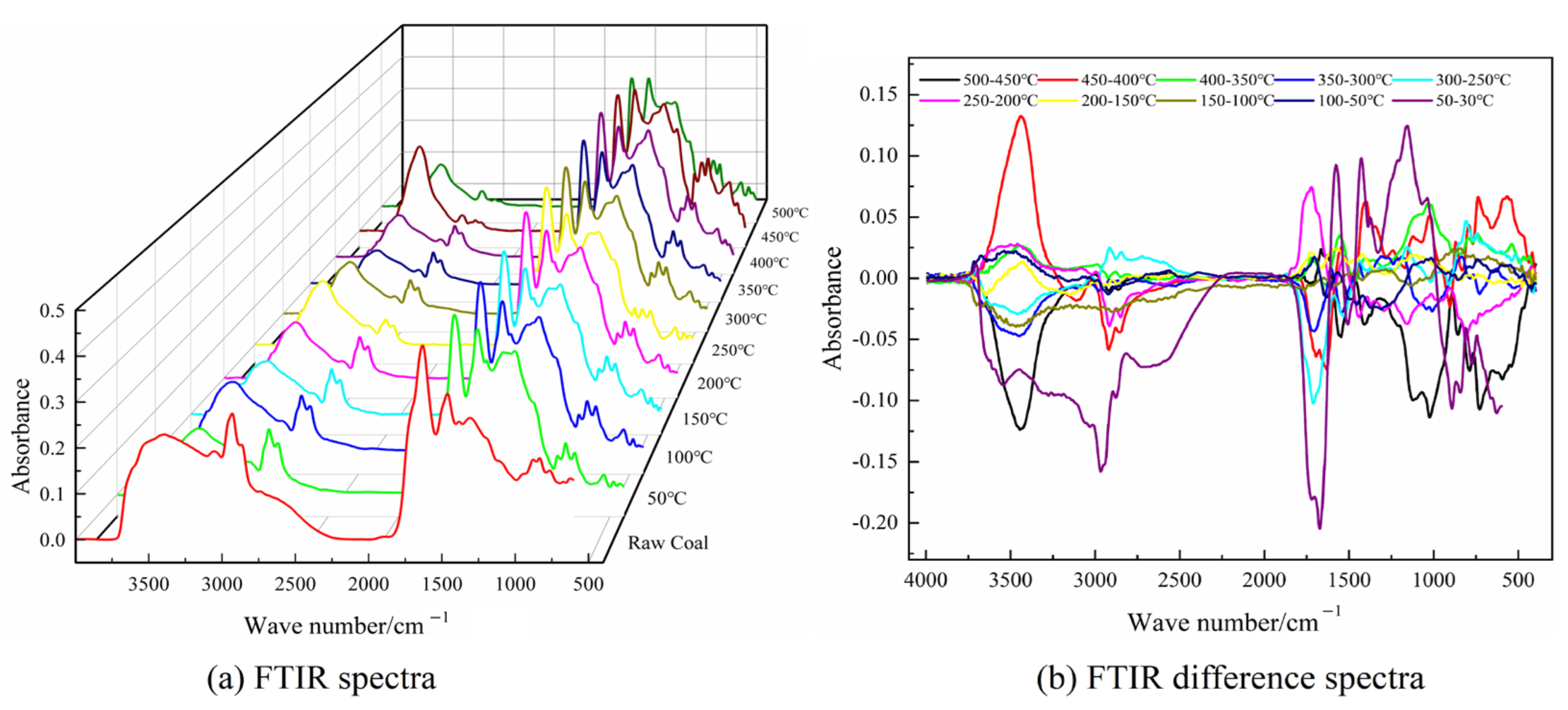
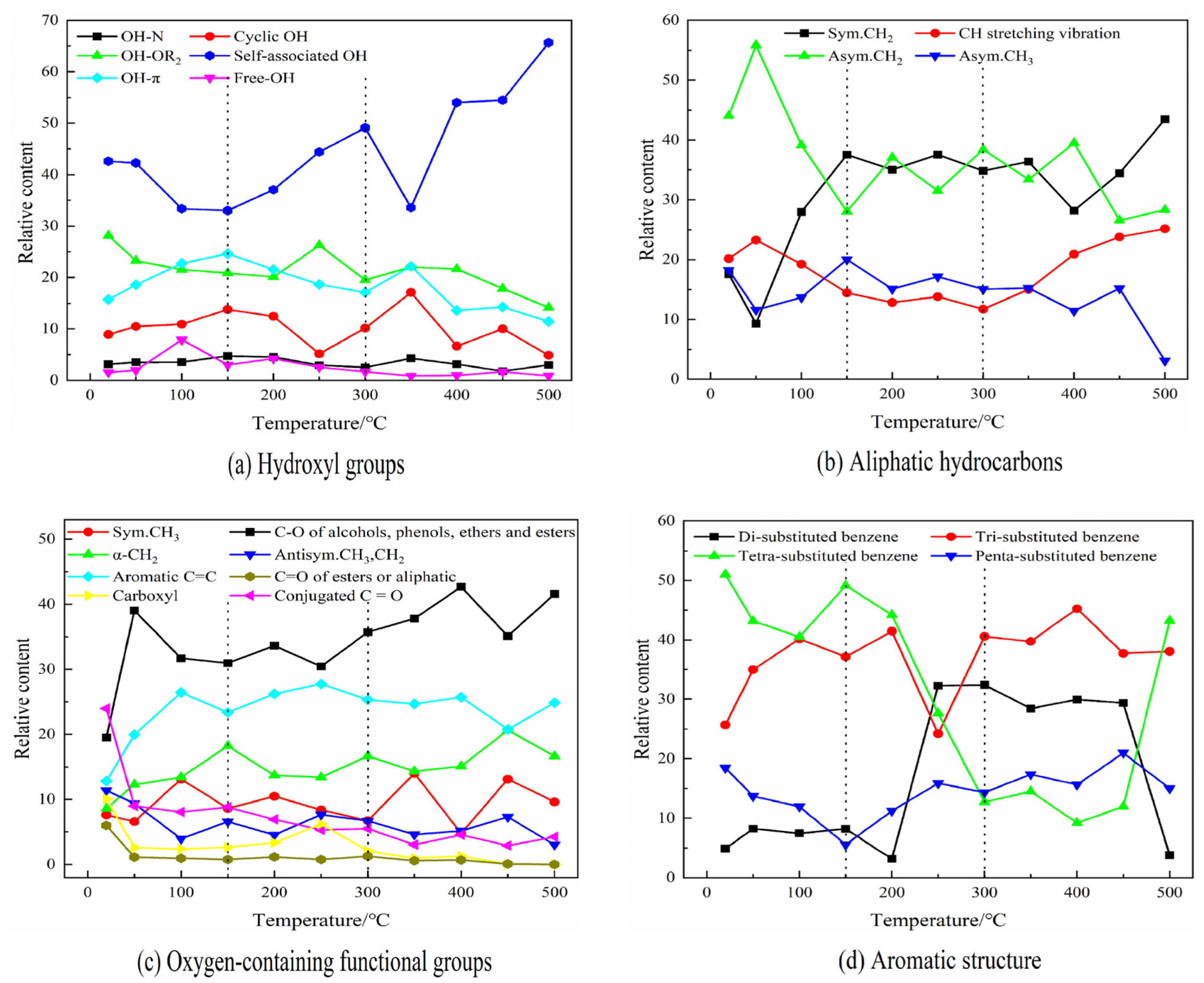
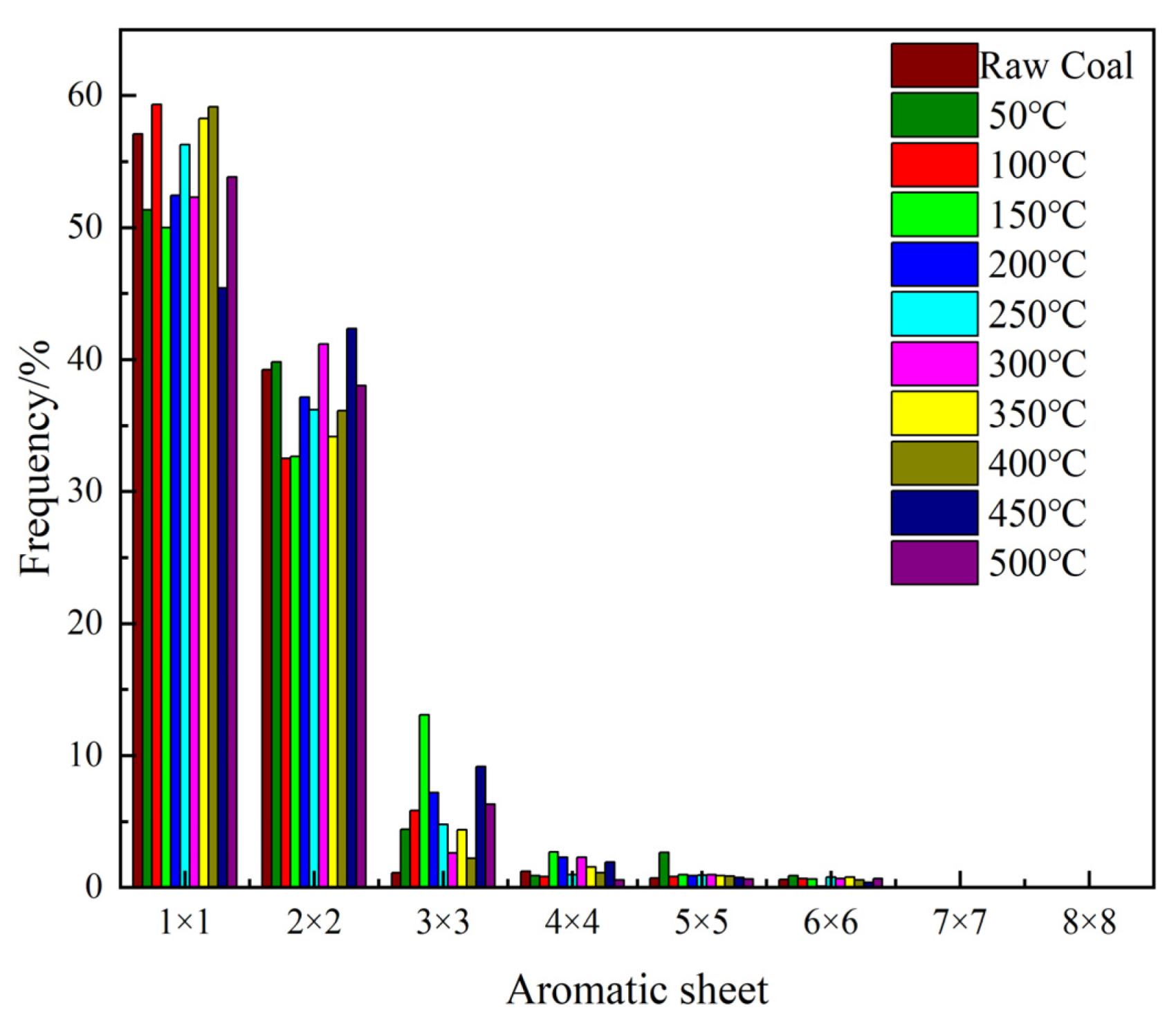
| Proximate Analysis/(mass)% | Ultimate Analysis/(mass)% | H/C | O/C | N/C | S/C | |||||||
|---|---|---|---|---|---|---|---|---|---|---|---|---|
| Mad | Aad | Vad | FCad | Cad | Had | Oad | Nad | St.d | ||||
| 2.59 | 3.73 | 37.33 | 56.35 | 72.36 | 4.73 | 15.12 | 1.34 | 0.14 | 0.784 | 0.157 | 0.016 | 0.001 |
| Peak | Centre | Peak Types | Area | Relative Content/% | Contribution |
|---|---|---|---|---|---|
| 1 | 14.1 | Gaussian | 1 814.09 | 7.56 | R-CH3 |
| 2 | 21.6 | Gaussian | 1 633.30 | 6.81 | Ar-CH3 |
| 3 | 29.7 | Gaussian | 2 383.72 | 9.94 | CH2-CH2 |
| 4 | 35.9 | Gaussian | 720.89 | 3.01 | CH2 |
| 5 | 40.8 | Gaussian | 946.70 | 3.95 | C, CH |
| 6 | 47.1 | Gaussian | 434.30 | 1.81 | C, CH |
| 7 | 53.6 | Gaussian | 665.65 | 2.78 | O-CH3, O-CH2 |
| 8 | 61.8 | Gaussian | 679.15 | 2.83 | O-CH |
| 9 | 111.0 | Gaussian | 1 224.70 | 5.11 | Ar-H |
| 10 | 119.5 | Gaussian | 1 910.83 | 7.97 | Ar-H |
| 11 | 127.1 | Gaussian | 3 860.11 | 16.09 | Ar-H |
| 12 | 135.7 | Gaussian | 2 026.58 | 8.45 | Bridgehead (C-C) |
| 13 | 142.4 | Gaussian | 1 321.31 | 5.51 | Ar-C |
| 14 | 153.2 | Gaussian | 1 951.87 | 8.14 | Ar-O |
| 15 | 177.9 | Gaussian | 7.07 | 0.03 | COOH |
| 16 | 182.9 | Gaussian | 331.23 | 1.38 | COOH |
| 17 | 193.8 | Gaussian | 1 219.87 | 5.09 | C=O |
| 18 | 205.2 | Gaussian | 690.99 | 2.88 | C=O |
| 19 | 217.9 | Gaussian | 162.38 | 0.68 | C=O |
| Parameters | ||||||||||||
|---|---|---|---|---|---|---|---|---|---|---|---|---|
| Percentage/% | 61.32 | 10.05 | 51.26 | 22.10 | 29.17 | 8.14 | 5.51 | 8.45 | 38.68 | 14.37 | 18.7 | 5.61 |
| Element | Binging Energy/eV | Width | Relative Content/% | Contribution |
|---|---|---|---|---|
| C 1s | 284.80 | 1.37 | 74.35 | C-C, C-H |
| 285.67 | 1.44 | 17.34 | C-O | |
| 287.1 | 1.43 | 5.57 | C=O | |
| 289.28 | 1.54 | 2.73 | COO- | |
| O 1s | 531.5 | 1.50 | 18.51 | C=O |
| 532.8 | 1.44 | 51.22 | C-O | |
| 534 | 1.36 | 28.52 | COO- | |
| 535.4 | 2.4 | 1.76 | Adsorbed oxygen | |
| N 1s | 398.91 | 1.92 | 31.85 | Pyridine nitrogen (N-6) |
| 400.29 | 1.44 | 44.73 | Pyrrole nitrogen (N-5) | |
| 401.4 | 1.58 | 15.57 | Quaternary nitrogen (N-Q) | |
| 403 | 2.40 | 7.85 | Oxidized nitrogen (N-X) | |
| S 2p | 163.66 | 1.44 | 36.83 | Aliphatic sulphur |
| 164.92 | 1.44 | 18.81 | Aromatic sulphur | |
| 168.48 | 1.44 | 29.36 | Sulfone | |
| 169.74 | 1.44 | 15.00 | Inorganic sulphate |
| Type | Number | Type | Number |
|---|---|---|---|
 | 1 |  | 4 |
 | 1 |  | 1 |
 | 1 |
| Molecular Structure | Molecular Mass | Elemental Analysis/% | |||
|---|---|---|---|---|---|
| C | H | O | N | ||
| C142H112N2O22 | 2198 | 77.58 | 5.14 | 16.01 | 1.27 |
| State | Total Energy | Valence Energy | Non-Bond Energy | |||||
|---|---|---|---|---|---|---|---|---|
| EB | EA | ET | EI | EH | Evan | EE | ||
| Initial condition | 6522.4 | 2181.5 | 87.8 | 218.8 | 6.9 | 0.0 | 4055.3 | −27.9 |
| Geometry optimization | 763.4 | 91.7 | 117.4 | 197.8 | 4.2 | 0.0 | 385.0 | −32.8 |
| Energy optimization | 669.3 | 82.0 | 102.1 | 184.8 | 4.8 | −5.0 | 329.3 | −28.4 |
| Peak | Centre | Peak Types | Area | Relative Content/% | Contribution |
|---|---|---|---|---|---|
| 1 | 3615.86 | Gaussian | 0.47 | 1.52 | Free-OH |
| 2 | 3541.91 | Gaussian | 4.83 | 15.72 | OH-π |
| 3 | 3433.72 | Gaussian | 13.09 | 42.58 | Self-associated OH |
| 4 | 3298.19 | Gaussian | 8.65 | 28.15 | OH-OR2 |
| 5 | 3178.91 | Gaussian | 2.74 | 8.92 | Tightly bound OH tetramers (Cyclic OH) |
| 6 | 3054.71 | Gaussian | 0.96 | 3.12 | OH-N |
| Peak | Centre | Peak Types | Area | Relative Content/% | Contribution |
|---|---|---|---|---|---|
| 1 | 2963.13 | Gaussian | 2.15 | 18.23 | Asymmetric stretching vibration of methyl (Asym.CH3) |
| 2 | 2928.58 | Gaussian | 5.20 | 44.03 | Asymmetric stretching vibration of methylene (Asym.CH2) |
| 3 | 2885.27 | Gaussian | 2.38 | 20.15 | CH stretching vibration |
| 4 | 2854.77 | Gaussian | 2.08 | 17.58 | Symmetric stretching vibration of methylene (Sym.CH2) |
| Peak | Centre | Peak Types | Area | Relative Content/% | Contribution |
|---|---|---|---|---|---|
| 1 | 1735.04 | Gaussian | 7.62 | 6.00 | Carbonyl stretching vibration of esters or aliphatic |
| 2 | 1691.12 | Gaussian | 12.82 | 10.10 | Carboxyl |
| 3 | 1627.73 | Gaussian | 30.44 | 23.98 | Conjugated C=O stretching vibration |
| 4 | 1556.19 | Gaussian | 8.87 | 6.98 | Aromatic C=C stretching vibration (Aromatic C=C) |
| 5 | 1505.35 | Gaussian | 7.41 | 5.83 | Aromatic C=C stretching vibration |
| 6 | 1458.50 | Gaussian | 14.41 | 11.35 | CH3 antisymmetric vibration, CH2 deformation vibration (Antisym.CH3, CH2) |
| 7 | 1393.27 | Gaussian | 10.93 | 8.61 | a-CH2 variable angle vibration |
| 8 | 1331.51 | Gaussian | 9.70 | 7.64 | CH3 symmetric deformation vibration (Sym.CH3) |
| 9 | 1276.46 | Gaussian | 9.40 | 7.40 | C-O vibration of alcohol, phenol, ether, and ester |
| 10 | 1223.11 | Gaussian | 5.79 | 4.56 | C-O vibration of alcohols, phenols, ethers, and esters |
| 11 | 1179.02 | Gaussian | 4.14 | 3.26 | C-O vibration of alcohols, phenols, ethers, and esters |
| 12 | 1135.96 | Gaussian | 2.52 | 1.98 | C-O vibration of alcohols, phenols, ethers, and esters |
| 13 | 1090.31 | Gaussian | 2.28 | 1.79 | C-O vibration of alcohols, phenols, ethers, and esters |
| 14 | 1045.47 | Gaussian | 0.66 | 0.52 | C-O vibration of alcohols, phenols, ethers, and esters |
| Peak | Centre | Peak Types | Area | Relative Content/% | Contribution |
|---|---|---|---|---|---|
| 1 | 886.02 | Gaussian | 0.15 | 5.10 | Penta-substituted benzene |
| 2 | 872.27 | Gaussian | 0.38 | 13.36 | Penta-substituted benzene |
| 3 | 851.97 | Gaussian | 0.37 | 12.86 | Tetra-substituted benzene |
| 4 | 831.32 | Gaussian | 0.78 | 27.17 | Tetra-substituted benzene |
| 5 | 811.87 | Gaussian | 0.31 | 10.94 | Tetra-substituted benzene |
| 6 | 788.16 | Gaussian | 0.12 | 4.17 | Tri-substituted benzene |
| 7 | 773.94 | Gaussian | 0.21 | 7.18 | Tri-substituted benzene |
| 8 | 758.16 | Gaussian | 0.41 | 14.35 | Tri-substituted benzene |
| 9 | 740.30 | Gaussian | 0.14 | 4.87 | Di-substituted benzene |
| Peak | 2θ/° | Peak Type | FWHM |
|---|---|---|---|
| γ | 12.94 | Gaussian | 6.15 |
| 002 | 23.63 | Gaussian | 7.72 |
| 100 | 45.32 | Gaussian | 14.35 |
| d002 | d100 | La | Lc | N | P |
|---|---|---|---|---|---|
| 3.76 | 12.00 | 12.27 | 10.98 | 2.92 | 0.34 |
| T1/°C | T2/°C | T3/°C | T4/°C | T5/°C | T6/°C | T7/°C |
|---|---|---|---|---|---|---|
| 85.4 | 162 | 229.4 | 278.7 | 461.4 | 531.6 | 668.8 |
| Parameters | Stage 1 | Stage 2 | Stage 3 | Stage 4 |
|---|---|---|---|---|
| E/kJ/mol | 55.758 | 57.615 | 133.693 | 194.013 |
| R2 | 0.95078 | 0.96408 | 0.93014 | 0.98407 |
Publisher’s Note: MDPI stays neutral with regard to jurisdictional claims in published maps and institutional affiliations. |
© 2022 by the authors. Licensee MDPI, Basel, Switzerland. This article is an open access article distributed under the terms and conditions of the Creative Commons Attribution (CC BY) license (https://creativecommons.org/licenses/by/4.0/).
Share and Cite
Ding, L.; Zeng, Q. Study on Characteristics of Coal Spontaneous Combustion in Kerjian Mining Area, Xinjiang, China. Minerals 2022, 12, 1508. https://doi.org/10.3390/min12121508
Ding L, Zeng Q. Study on Characteristics of Coal Spontaneous Combustion in Kerjian Mining Area, Xinjiang, China. Minerals. 2022; 12(12):1508. https://doi.org/10.3390/min12121508
Chicago/Turabian StyleDing, Lili, and Qiang Zeng. 2022. "Study on Characteristics of Coal Spontaneous Combustion in Kerjian Mining Area, Xinjiang, China" Minerals 12, no. 12: 1508. https://doi.org/10.3390/min12121508
APA StyleDing, L., & Zeng, Q. (2022). Study on Characteristics of Coal Spontaneous Combustion in Kerjian Mining Area, Xinjiang, China. Minerals, 12(12), 1508. https://doi.org/10.3390/min12121508





